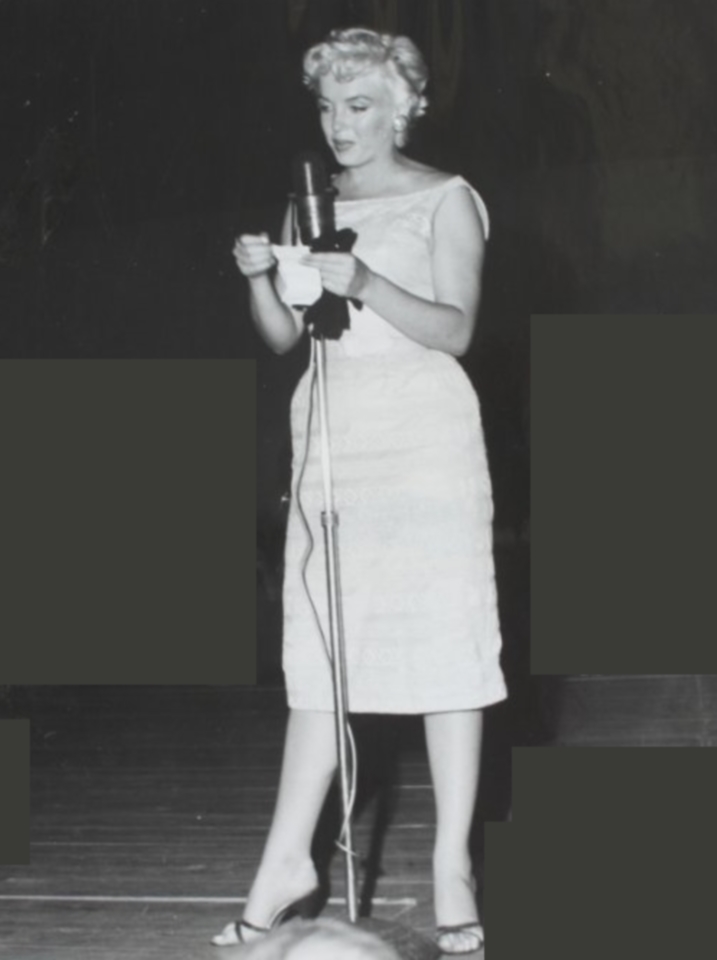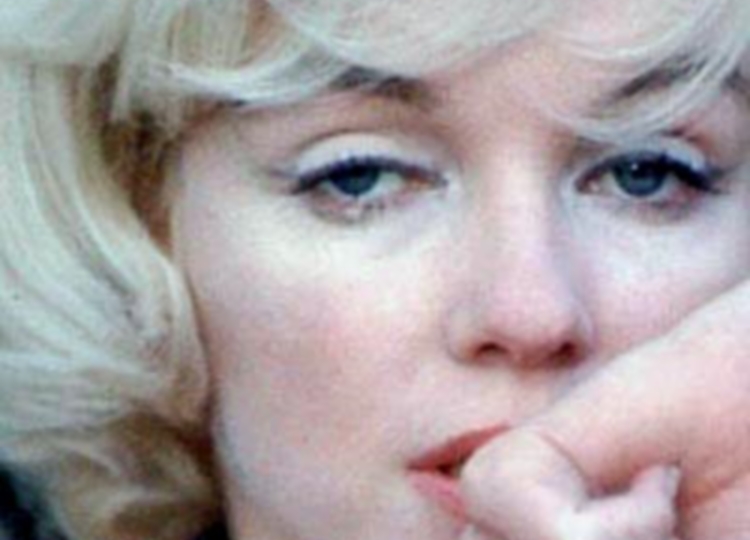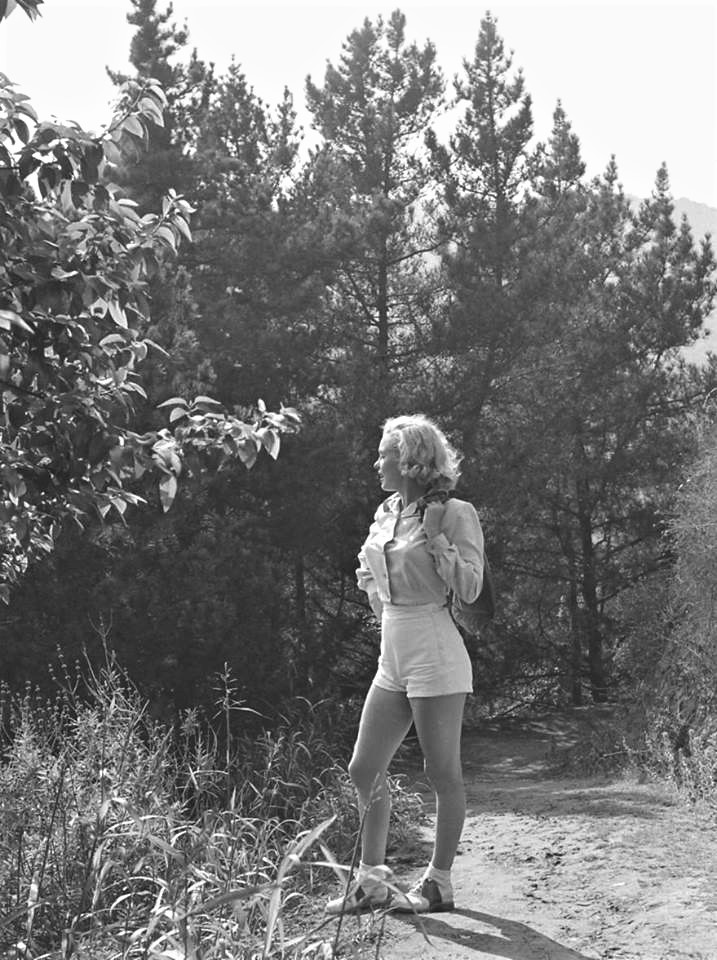William Woodfield and Joe Hyams
Certainly, if you believe the testimony of William Woodfield and Joe Hyams, then you must dismiss the testimony of the contingent at the Bates Ranch; and therefore, we are left with an all too common problem regarding testimony relative to Marilyn’s death: the word of one against the word of another, or in this case, conflict regarding the words of several. But an examination of just how the previously cited three books presented the helicopter log discovery story will reveal several interesting considerations. What follows now are synopses of the accounts offered by Summers, Wolfe and Margolis–Buskin.
Summers: Goddess: The Secret Lives of Marilyn Monroe. 1985. eBook 2014:
Joe Hyams and his policeman assistant both confirmed the rumor that a helicopter landed on Santa Monica Beach late on the night of August the 4th, dispatched by a small, local helicopter service frequently used by Pete Lawford and several other celebrities. When Hyams visited the company on August the 6th, the man in the office that day allegedly admitted, according to Hyams, that one of the company’s helicopters landed on Santa Monica Beach on August the 4th; but he would not reveal the name of the passenger. He also refused Hyams’ request to review the company’s flight records. Hyams asserted that he was unceremoniously invited to leave.
On the day of Marilyn’s enshrinement at Westwood Village, Hyams’ investigative partner, William Woodfield, revisited the helicopter service. The man staffing the outer office on that date was a pilot with whom Woodfield had flown once before. During that flight, since Woodfield was writing an article about Frank Sinatra’s airplane, he snapped several air to ground photographs of the singer’s custom Martin 404, Christina, named after a daughter. Apparently, Woodfield never bothered to ask the pilot his name. After a brief conversation about their prior flight, Woodfield lied to the man, asserted that he had been commissioned to prepare an additional article about how celebrities often use helicopters. Woodfield also asserted that he and the pilot had discussed just such an article during their prior flight to photograph Christina. This apparently then unknown pilot, who was interested in the positive publicity such an article would provide, allowed Woodfield to flip through the company’s log book, allegedly searching for the names of celebrities. On the log’s page dedicated to August the 4th, Woodfield found an entry which indicated that a helicopter had been rented on the night of Marilyn’s death and dispatched to Santa Monica Beach; but he could not recall the exact time noted on the log. He narrowed the time frame down to a two hour window between 12:00 midnight on August the 4th and 2:00 AM on August the 5th. Both Hyams and Woodfield assumed and then asserted that the helicopter had been rented to collect Attorney General Robert Kennedy.
A day later, on the 9th of August, the investigators testified, they telephoned Robert Kennedy’s office at the Department of Justice, related their story to an aide and asked for a response from the attorney general; his response arrived not long thereafter. Through his aide, Robert Kennedy asked the journalists not to reveal the information that they had uncovered; but despite Robert Kennedy’s request, Hyams telephoned the story to the Herald Tribune in New York City. Not long thereafter, during a return telephone call, the senior editor of the newspaper informed Hyams that the Herald Tribune would not print and thereby killed the story. Even though the Herald Tribune was a Republican newspaper, the editor admitted, the helicopter log story amounted to a guilt by association assault on President John Kennedy; and the newspaper would not participate in such a tactic. Apparently, at that point, Woodfield and Hyams simply returned to their lives as photographers and journalists. Just like Detective Lynn Franklin, the photojournalists merely dropped the matter.
Wolfe: The Last Days of Marilyn Monroe. 1998. eBook 2012:
Donald Wolfe’s account of the helicopter log’s discovery differed slightly from Anthony Summers’ account even though Wolfe cited Summers as a source. Wolfe, for example, omitted Hyams’ unsuccessful and tense initial visit to the helicopter rental company; and according to Wolfe, Woodfield reported that he telephoned Marilyn’s psychiatrist, Dr. Ralph Greenson, in an attempt to reconstruct Marilyn’s last hours alive; but Greenson refused to talk. That assertion by Woodfield did not appear in the Summers’ account. Also according to Hyams according to Wolfe, the photographers filed the helicopter log story with the Herald Tribune and telephoned Robert Kennedy’s office either on the Monday or the Tuesday following Marilyn’s funeral, an assertion placing the date of the telephone call to the Herald Tribune on either the 13th or 14th of August, dates which contradicted the statements Woodfield and Hyams made to Summers. Perhaps an innocent contradiction, considering that over a decade had elapsed since Summers had interviewed them and over three decades had elapsed since 1962; but the journalist’s statements to Wolfe represent a contradiction nonetheless.
The elapsed time also accounts, possibly, for the discrepancies between the direct quotations offered by Summers and those offered by Wolfe. Summers reported that Woodfield said: The time in the log was sometime after midnight―I think between midnight and two in the morning (Summers 506). Wolfe reported that Woodfield said: The time in the log was approximately two o’clock Sunday morning (KE:P1:8). Regarding the aide’s response to the investigator’s alleged telephone call to Robert Kennedy’s office, Summers reported that Woodfield said: The Attorney General would appreciate it if you would not do the story (Summers 506-507) whereas Wolfe reported that the response from the attorney general’s office was: The attorney general would appreciate it if we didn’t file the story (Wolfe KE:P1:8). Certainly minor differences; but why interview Hyams and Woodfield, risk the possibility of contradictions and differences, since in Wolfe’s bibliography, he cited Summers as a source?
Margolis and Buskin: The Murder of Marilyn Monroe: Case Closed. 2014:
The account presented by Margolis and Buskin is the very essence of brevity and relied completely on Summers, who they cited as their source. Still, within the literary space of three paragraphs, the authors appeared to confuse the date of the flight to and from Santa Monica Beach. In Goddess, Summers asserted Woodfield discovered a log entry for August the 4th during a two hour window between 12:00 midnight and 2:00 AM. However, according to Margolis and Buskin, Woodfield discovered a log entry for August the 5th, also between 12:00 midnight and 2:00 AM.
Midnight is a confusing time designation, is it not? I have read that most authorities on time, whomever those authorities may be, recommend caution using the term midnight. Generally recognized as the moment when the date changes, using that term is like posing the following indefinite question: where was the man when he jumped off the bridge? You could answer, on the bridge, to which the response could be, no … that was before he jumped; or you could answer, in the air, to which the response could be, no… that was after he jumped. At or after midnight of August the 4th is not the same as at or after midnight on August the 5th. The importance of the difference is certainly apparent.
Likewise, an examination of exactly how Summers related the amazing helicopter log story in Goddess will also provide several interesting considerations. Summers asserted that a helicopter landed on Santa Monica Beach close to Peter Lawford’s beach house. I, for one, am not exactly sure how to interpret the word close, meaning near to. Did the helicopter land at Lawford’s beach house or did it not? Considering the arrangement of beach houses, which stand in a rigid single file, like a line of soldiers, along and facing Santa Monica beach, if a helicopter touched down next door to Lawford’s house or even next door to next door, the whirlybird would have been within spitting distance of the actor’s swimming pool. Besides, is it possible that Lawford’s beach house was often used as a beach landmark?
Summers noted that the rented helicopter landed to collect a passenger and then to deliver that passenger to the main Los Angeles airport, meaning, I assume, Los Angeles International. It is clear that Summers considered the alleged helicopter log to be definitive evidence, definitive proof that Robert Kennedy was in Los Angeles the day Marilyn died; and Summers reiterated and thereby advanced what Norman Mailer had asserted twelve years earlier in his novel biographical novel: the attorney general escaped from Santa Monica in a helicopter.
However, a side by side comparison of Summers’ 1985 initial version of Goddess and his 2012 updated version revealed a troublesome issue: the testimony attributed to Woodfield in the initial version is appreciably and suspiciously different than the testimony attributed to the photojournalist in the 2012 version. Additionally, according to Summers’ source notes, the pathographer interviewed Woodfield in both 1983 and 1984; but, based on Summers’ 2012 source notes, the investigative journalist did not re-interview his photojournalist source following the original two interviews; and Woodfield died on November the 24th in 2001, eleven years before Summers published his updated 2012 version of Goddess, twenty-two years ago this year.
The differing testimony follows hereafter.
In the 1985 version of Goddess, Summers quoted Woodfield as follows: The time in the log was sometime after midnight―I think between midnight and two in the morning. The booking is a blur in my memory now, but it was definitely in the name of either Lawford or Kennedy (emphasis mine). Odd use of the word definitely, at least in my opinion, considering that Woodfield’s recollection was definitely not definite—just a memory’s blur; but then, according to Goddess 2012, Woodfield reported the following: The time in the log was sometime after midnight―I think between midnight and two in the morning. It showed clearly that a helicopter had picked up Robert Kennedy at the Santa Monica Beach. Odd. Why the glaring and incredible difference? Summers did not attempt to explain or account for the contradictory statements attributed to Bill Woodfield, who died eleven years before Summers published his updated 2012 version of Goddess. When did William Woodfield alter his testimony?
Also, I must take issue with Woodfield’s assertion and belief that the log showed clearly a helicopter picked up Robert Kennedy. Showed clearly? How exactly? Not at any time did Summers, Hyams or Woodfield, nor anybody else for that matter, assert unequivocally that Robert Kennedy’s name was written on that helicopter log. It appears as if someone, either Hyams, Woodfield or Summers, made a quantum leap from passenger to Robert Kennedy because either the photographers or Summers, or all three, simply wanted Robert Kennedy to be the clearly unnamed passenger.
Moreover, why did Summers exclude the testimony of Woodfield’s partner, Joe Hyams? The author’s source notes indicated that he interviewed Hyams on three different occasions, in 1983, in 1984 and again in 1985. Did Summers fail to tape record Woodfield’s partner? Not only did Summers selectively exclude the testimony of Hyams, Summers also selectively excluded the testimony of the retired policeman who had assisted Woodfield and Hyams with their investigation in 1962. Summers’ source notes indicated that he interviewed the retired policeman; but we are left to speculate regarding to what the retired policeman possibly testified and why Summers excluded the officer’s possibly relevant testimony.1Also, none of Woodfield’s taped testimony, as presented in the Netflix purported documentary film, The Unheard Tapes, appeared in the 1985 version of Goddess; and, of course, Summers did not mention Joe Hyams or the unnamed retired policeman during the Netflix film.
During the fifteen years following the initial publication of Summers’ pathography, he continued to investigate the helicopter log story reported by Woodfield and Hyams, leading a fellow to speculate that Summers possibly doubted his sources; and as a result thereof, he learned that Hal Conners, who by that time was deceased, not only owned the small helicopter service most often used by Peter Lawford, he was also the pilot who certainly flew the helicopter on August the 4th, if we briefly accept that such a flight actually occurred. Hal Conner’s ownership, his status as pilot and his relationship to the alleged helicopter flight only became clear in later editions of Summers’ book when he revealed the other pilots who had flown helicopters for Conners in 1962, James Zonlick and Ed Connelly.
Zonlick, who had been Conners’ chief pilot in 1962, was living in the Sunshine State when Summers located him. The author did not indicate what position Connelly held, if any, in Conners’ whirlybird company; and he did not indicate where Connelly was living at the time of his interview. During those interviews, both Zonlick and Connelly repeated for Summers what they recalled Conners had told them in 1962. According to Zonlick, Conners stated that he had picked-up Robert Kennedy at Santa Monica Beach and delivered him to the Los Angeles International Airport. Ed Connelly testified only that Conners talked about landing on the beach without the aid of landing lights, evidently an aberrant maneuver for Conners and one which apparently made the pilot giddy.
Summers then reported that Zonlick could not remember the exact date of the Robert Kennedy flight Conners had mentioned; and likewise, Connelly could not pin point the date of the aberrant landing flight that Conners had mentioned to him. So the exact dates of those flights remained unconfirmed. Zonlick believed, however, that the trip to collect and deliver Robert Kennedy occurred during the right time frame, probably during the latter half of 1962, meaning what, exactly, that Conners might have flown Robert Kennedy during the months of June, July, August, September, October, November or December of the correct year? Not exactly compelling evidence or proof that the Conners’ flight with Robert Kennedy actually occurred on August the 4th in 1962; and once again, it is entirely possible, in my considered estimation, that Zonlick conflated Conners’ statements about shuttling Robert Kennedy to LAX with Marilyn’s death and August the 4th in 1962. Like Ward Wood, Zonlick testified to Summers more than two decades after Marilyn’s death, after more than two decades of innuendo and insinuation in publications and documentaries about Marilyn’s death and the middle Kennedy brother’s accepted affiliation therewith. Please note, significantly, that Connelly did not evoke the name of Robert Kennedy; and it is reasonable to assert that Zonlick, like Ward Wood, simply succumbed to the overwhelming influential power of the media.
We know that Conners was the pilot in the office on August the 6th when Hyams visited and then on August the 8th when Woodfield visited: neither Zonlick nor Connelly told Summers that they had encountered the photographers and neither mentioned an attempt by anyone to inspect the company’s flight records. It is an oddity, in my opinion, that Woodfield allegedly had flown at least once before with Hal Conners; but Woodfield apparently did not know Conners’ name or that he owned the helicopter service. At least Woodfield did not report as much to Summers. It is also an oddity, in my opinion, that on the 6th of August, Hal Conners refused to allow Hyams to inspect the flight records and would not reveal the name of his passenger; but then on the 8th of August, only one day later, under the flimsy pretense of receiving some positive publicity for his already popular and frequently hired helicopter service, Hal Conners allowed Woodfield to inspect the flight records which he, Conners, must have known would reveal the name of his passenger―unless, that is, the name of his passenger, Conners knew, was not inscribed in that log.
Why did Woodfield telephone Dr. Ralph Greenson, as reported by Donald Wolfe, in an attempt to reconstruct Marilyn’s last few hours alive? Greenson was not with Marilyn during her last few hours alive: she was alone in her bedroom. Woodfield should have telephoned Eunice Murray; but then, that telephone call would have been as silly as the alleged telephone call to the Justice Department in an attempt to reach the attorney general. What did Hyams and Woodfield expect or want Robert Kennedy to admit or reveal? But then, according to Summers, neither photojournalist actually spoke to the attorney general: the man on the other end of the telephone was Robert Kennedy’s aide; and how did Anthony Summers miss interviewing that aide? Considering the sensitive nature of the information putatively discovered by Hyams and Woodfield, a fellow might expect that Robert Kennedy would have taken the receiver of the telephone himself and discussed the issue directly with Hyams in rather stern and cautionary tones; but then, Robert Kennedy was faced once before with a similar ploy by J. Edgar Hoover, who notified the attorney general of an eavesdropped conversation between Meyer Lansky and Lansky’s wife. During that recorded conversation, the mobster putatively stated that Robert Kennedy had been involved sexually with a woman in El Paso, Texas. According to Robert Kennedy’s friend and assistant, John Seigenthaler, Hoover received a guardedly terse response from the attorney general, who noted that he had never visited El Paso and had never known a woman from that city; so the allegation was obviously baseless. He then stated a fact of which Hoover was most certainly aware, since the FBI director was one himself: gossip-mongers just have to talk.2It is probably more accurate to call J. Edgar Hoover a quidnunc, a person who endeavors to learn and use all the latest gossip to achieve defamatory or negative ends.Robert Kennedy was aware of other rumors about his personal life, he informed J. Edgar, like the rumor that he was currently or had once been involved with the actress Marilyn Monroe. At least I have met Marilyn Monroe, the attorney general informed Hoover according to Seigenthaler, a good friend of my sister, Pat Lawford.3“‘Fiction, Falsehood’ about the Kennedys.” John Seigenthaler. The Courier-Journal, Louisville, KY. Sunday. 8 Aug 1993.
If we accept briefly that a telephone call to his office at the Justice Department actually occurred, Robert Kennedy undoubtedly realized there was nothing he could do to prevent people from talking and, as he said, gossipmongering; and asking the photojournalists through his aide not to run with the story actually proved nothing except a desire to avoid even more gossip mongering and rumoring.
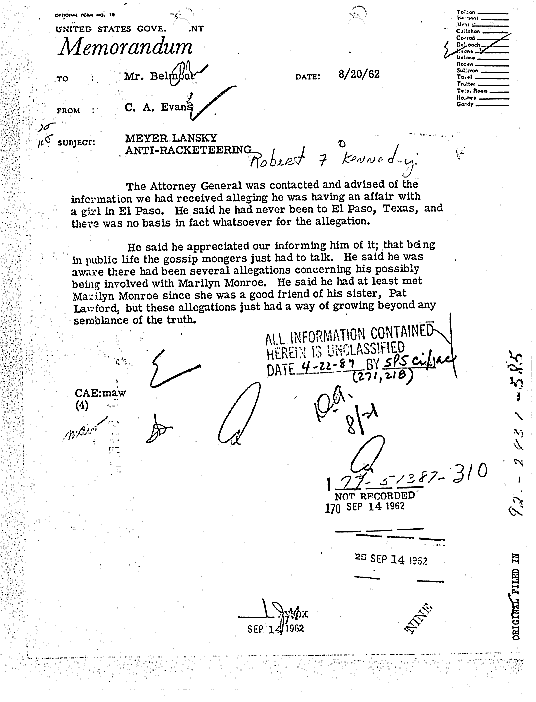
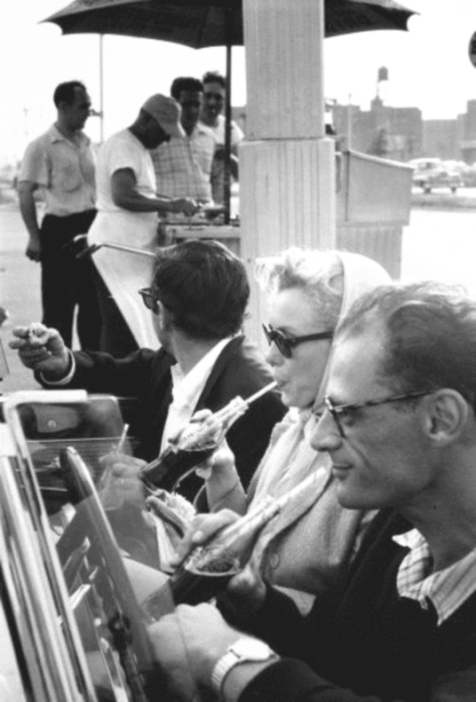
Why did Hyams and Woodfield stop investigating Marilyn’s death considering the explosive evidence that they had allegedly discovered? I assume, and I also conclude, that the two investigators discovered the only detail about Marilyn’s death in which they were actually interested. Perhaps they assumed, and also concluded, after the Herald Tribune declined to print their story about the helicopter log, that any additional research into the circumstances of Marilyn’s death would have been futile. But then, most certainly other publications, newspapers and magazines would have been incredibly interested in their story. The Globe, a tabloid for which Woodfield occasionally worked, would have been interested in the helicopter log story and any other uncovered details. At least I assume that would have been the case since the story involved Marilyn Monroe’s death and Robert Kennedy. Still, Hyams and Woodfield dropped the issue like the proverbial steamy potato.
Since none of the books which recounted the helicopter log story contained a copy of the actual log itself, and since the Herald Tribune killed the story, meaning they did not attempt to obtain a copy of the log, either, and the investigators never pursued any other media outlet, the log itself has never been seen by any persons other than Joe Hyams and Bill Woodfield―that is, they claimed they saw it. I have a question, though: why did they fail to ask for a copy of that explosive log?
During the five decades since Marilyn’s death, that mysterious helicopter log has never surfaced; and I must ask: was there not a flight plan to be uncovered, one filed with aviation officials, perhaps a trip manifest which indicated a point of departure and destination with intermittent landing sites identified, filed either with the city or the county of Los Angeles or the FAA? Or am I to assume that in 1962 flight plans were not required over areas like Los Angeles, afflicted with both densely populated land and skies? Was there no log for the trip from Gilroy or San Jose or San Francisco, if, as asserted by Milo Speriglio and Donald Wolfe, Robert Kennedy arrived in a private chartered helicopter. Additionally, were radio communications between flying aircraft and traffic control towers unrecorded in 1962? Nothing like a flight plan or a trip manifest or a tower recording of a radio communication with Hal Conners, or any other Robert-Kennedy-transporting-pilot for that matter, has ever surfaced or even been mentioned.
I assume that neither Anthony Summers nor Milo Speriglio nor Donald Wolfe nor authors Margolis and Buskin could find the justice department or military chauffeur who must have driven Robert Kennedy to the awaiting helicopter somewhere near Gilroy and the Bates’ ranch and then back to the Bates’ ranch after the return flight from Los Angeles; and likewise, the conspiracist authors could not find the pilot, military or otherwise, who actually flew the whirlybird from Gilroy to Los Angeles or somewhere near Los Angeles and then back to Gilroy. I can only assume so because our conspiracist authors did not provide the testimony of or even mention those men.
Additionally, I could pose a passel of questions to that flyboy. For instance, what were the circumstances surrounding his encounter with the Attorney General of the United States? Were the dangerous flights tense? How did he occupy himself between flights, the one from Gilroy to Los Angeles and then back? Did he play cards, sleep, call home between flights: what exactly and precisely? But alas, legitimate questions such as those can never be answered, not unlike this question: which travel scenario presented by the conspiracists is the correct one, the one presented by Speriglio or Summers or Wright or the one presented by the serial fabulist, C. David Heymann. Each is mutually exclusive; and therefore, not all of them can be factual. All things considered, the multiplicity of accounts cast reasonable doubt on each.
One final point. Considering that Marilyn’s death was not reported publicly until the morning of August the 5th, how could Joe Hyams and William Woodfield have known on the 5th that Robert Kennedy’s location the previous day was significant or, at least, would eventually become conspiratorially significant. If we construct a time line according to their testimony to Summers, they decided, on August the 5th, to delve deeper into the circumstances surrounding the tragic event; however, their telephone call to the Justice Department and Robert Kennedy transpired on August the 9th, only four days following Marilyn’s death. Also, they learned of the helicopter landing when they conducted interviews with Peter Lawford’s nearby neighbors; but then, when did they, along with their retired policeman assistant, conduct those interviews, on the afternoon of August the 5th or the morning of August the 6th? Those interviews led directly to Hyams aborted visit with the helicopter company during working hours on August the 6th. Woodfield visited the helicopter company on the 8th of August, which led to the 9th’s telephone call to Robert Kennedy’s office. The prescience of Hyams and Woodfield, and the speed with which they uncovered the facts about Robert Kennedy’s alleged location of August the 4th, was certainly remarkable, in fact, downright implausible if not downright unbelievable. I could, of course, make the same statements about Detective Lynn Franklin and his aborted quest to find the truth about Marilyn and Robert Kennedy, a quest which allegedly began on August the 6th and ended on August the 9th. If for a moment we accept Donald Wolfe’s scenario, in which Hyams placed the date of the odd telephone call to Robert Kennedy’s office and then to the Herald Tribune on either the 13th or the 14th of August, nothing actually changes regarding the prescience of Hyams and Woodfield since the photojournalists visited Hal Conners’ Helicopter Service on the same dates in either scenario.
Once again, if you believe the testimony of William Woodfield and Joe Hyams, then you must dismiss the testimony of John and Nancy Bates, John Bates, Jr. and Roland Snyder. Their testimony was based on first hand observation and is therefore essential evidence, neither hearsay nor circumstantial; it cannot and should not be dismissed.
Still, to ask what would motivate Woodfield and Hyams to lie is a legitimate question which, honestly, I cannot answer; but the same question could be posed about the Bates Ranch contingent: why would they lie? Would John and Nancy Bates make themselves, along with their son, accessories to murder. Would Roland Snyder do the same? To me, that is an extremely remote possibility at best.
Perhaps the more germane question is this one: why did William Woodfield and Joe Hyams have to be discovered by Anthony Summers, discovered twenty years after the death of Marilyn Monroe? Neither are mentioned by Norman Mailer nor Robert Slatzer; and they are not mentioned in the Summary Report published by the district attorney in 1982. That Summary Report states: Newspaper articles provided to this office place Robert Kennedy in San Francisco the weekend of Miss Monroe’s death (SR ZZ). Certainly not a precise assertion regarding Gilroy and the Bates family; but do the photojournalists appear in any official report at all, even obliquely? No, they do not; therefore, since I must choose whom to believe, I choose to believe the Bates’ testimony, if for no other reason than they are specifically named in at least two official FBI reports confirming Robert Kennedy’s location the weekend of August the 4th in 1962; and they are referenced indirectly in the Summary Report published by the district attorney in 1982―and then there are those niggling Bates family photographs. According to the Bates’ testimony, and the testimony of Roland Snyder, the attorney general did not, at any time, leave their ranch during that weekend; and nothing asserted by Anthony Summers and nothing asserted by William Woodfield or Joe Hyams disproves John Bates’ assertion or renders his testimony suspect.
